The Great Hollyleaf Redberry Mystery
July 14, 2012 | Updated June 22, 2020
As an Amazon Associate I earn from qualifying purchases.
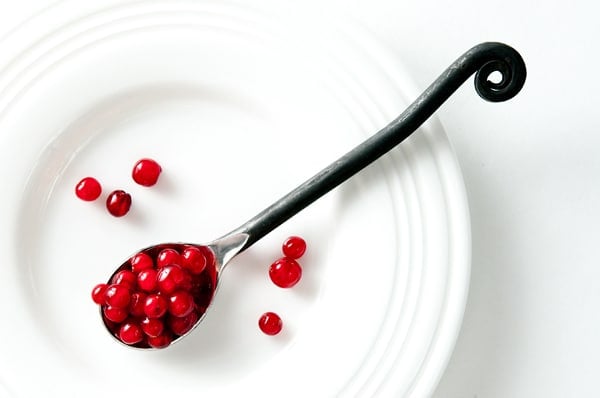
One day I took a walk. On that walk I saw a bush I’d seen before, only this time it had so many scarlet berries on it the plant looked like an overzealous father had decorated it for his neighborhood Christmas contest. I stopped and stared. The berries were so luminous the almost glowed from within.
But they were red, and red berries have a bad habit of being toxic in North America. I left them alone and walked on.
Something in the back of my head started itching. I have an unusually good memory for patterns and photographs, which serves me well as a forager. And I knew, just knew, that I had seen this plant in one of my edible plant books. But I couldn’t place it mentally. I walked back to the bush and looked at it again, this time with an eye toward remembering its tiny details.
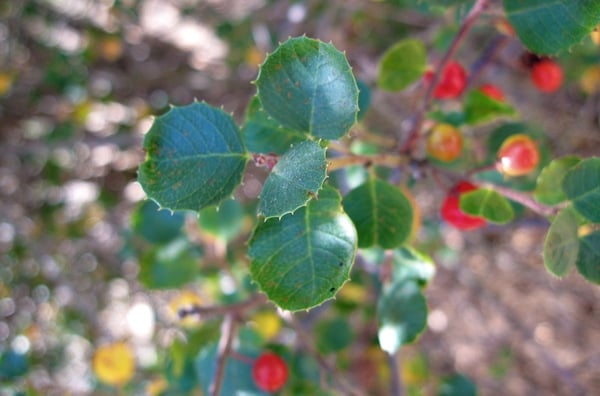
When I got home I opened up my books. Huh. Nothing. Maybe the internet could help. But how to find it? Well, the bush had red berries and little leaves that looked like holly. So I typed in “holly leaf red berry.” And found that the bush is actually called holyleaf redberry. Go figure.
My next searches are always to add the terms “edible” and “toxic” to the plant. And here’s where things get weird. Both came up. What’s more, searches on what appeared to be the plant’s Latin name, Rhamnus ilicifolia, turned up precious little on either the edibility or the toxicity of this plant. Finally I found a reference to it being edible.
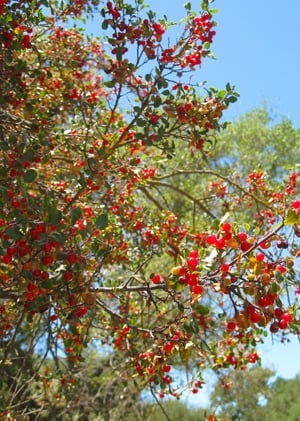
I returned to the bush and picked a berry. I tasted it on the end of my tongue, as I do a lot with unknown berries. If the taste is bitter or unpleasant, the berry will either be unripe or downright toxic. You then spit everything out. This berry was soft, a little sticky and had two large seeds inside. I crushed it against the roof of my mouth and immediately got a hit of sweetness. A good sign. Then a hit of cherry, followed by an aftertaste like cinnamon. A very good sign. Still, I spit out the berry for safety’s sake. But I picked a little jar full to take home, just in case.
Back to the research. One of the things any decent forager does when faced with a new plant is to check with the Indians. If the people who came here first — and were here for 10,000 years before we showed up — never used a plant, you can be pretty damn sure there’s something wrong with it.
Thankfully there are several Native American ethnobotany databases online, including this excellent one from the University of Michigan.
Oddly, a search of R. ilicifolia only turned up evidence that the Indians used the bark to help treat rheumatism. No word on the berries. Huh. Search after search, in places like the Jepson Manual, the USDA database and other places, turned up little or nothing on this plant.
Now I started to get nervous. But I’d been doing the “sweet test” on berries with my tongue for 30-plus years and it had always worked. Could there possibly be a toxic berry that is also sweet? There had to be an explanation.
More searching. Finally, I came across a piece of data noting that R. ilicifolia was not an actual genus-species name, like Homo sapiens. It was shorthand for Rhamnus crocea var. ilicifolia. So ilicifolia is a subspecies name! Off to another database, this one the Integrated Taxonomic Information System.
This is where you go when you want to cut through a confusion of Latin names — and that happens more than you think. Everyone wants to name a new species of something, so you often get competing names for the same plant. The ITIS is the arbiter. And there it was: Not only was R. ilicifolia a subspecies name, it is an “unaccepted” name, too. Apparently the official subspecies name for this plant is R. crocea ssp. pilosa.

That changed everything.
There is a ton of data on Indians eating the berries of R. crocea. All these subspecies came about because the bush can have leaves of a different shape depending on where it is; the one on my walk happened to have holly-like leaves. Some have smoother leaves. But all the berries are edible, although some are better than others.
Why did I bother to tell you all this? Because it is important to not mess around with new plants until you are 100 percent certain they are edible, and if so, how are they edible. Take the yew, for example. The flesh of yew berries is delicious, but the seed inside is highly toxic, and in large doses can even be fatal. I needed to know this sort of information with the hollyleaf redberry before I could experiment with it, and, more importantly, tell all of you about it.
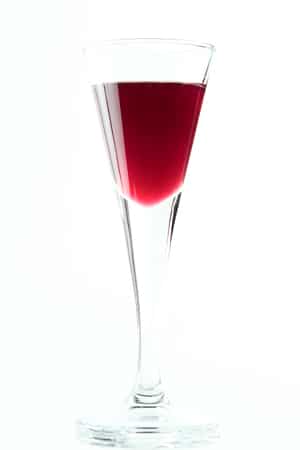
So what did I finally do with my redberries? I did what I do with any seedy berry: I made syrup. How I will use that syrup remains to be seen, but it is a powerful flavor. It’s as if cinnamon and a cherry had a love child, with a little bit of that funky aroma you get with a highbush cranberry. I suspect it will go really well in a pan sauce with wild duck.
If you want to go get some yourself, you’ll have to be in Oregon, California or Arizona. The plant only lives there. If you don’t live in R. crocea’s range, use this post as a model for any new berry you may encounter: There are literally hundreds of edible berries in North America, and no one can know them all.
Hollyleaf Redberry Syrup
Ingredients
- 1 cup sugar
- 1 cup water
- 3 cups hollyleaf redberries
Instructions
- Melt the sugar in the water in a small pot set over medium heat. Once the sugar has melted, add the berries and bring to a simmer. Turn off the heat, crush the berries with a potato masher and cover the pot. Let this steep off the heat for at least 1 hour, and preferably 4-6 hours.
- Set a food mill with the fine plate over a bowl. If you don't have a food mill, use a medium-meshed strainer set over a bowl. Pour the berry mixture through the strainer or food mill and sift out all the seeds. It's your choice whether to let the pulp get into your syrup. I like having some in there. Pour the finished syrup into a glass jar and keep refrigerated.
Nutrition information is automatically calculated, so should only be used as an approximation.
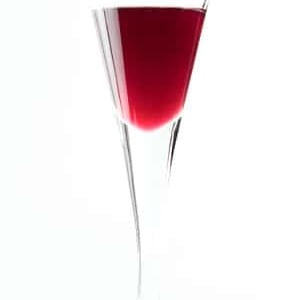
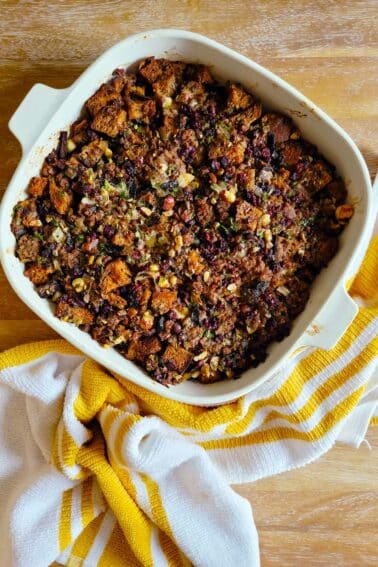
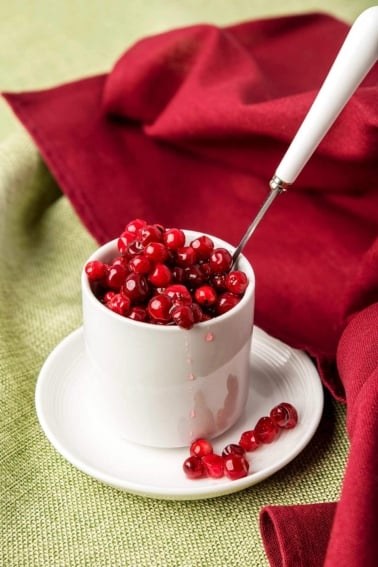


Yes I tried these berries today and they are incredibly sweet and very tasty
Thank you! I first saw this berry more than 10 years ago and it wasn’t until last year I found it in an edible plants of California field guide.
I’m so glad I did! I love them.
I’m inclined to agree that your Rhamnus Crocea subspecies Iliciflora is edible. On the other hand, it’s classified as poisonous and toxic by Cal Poly San Luis Obispo Urban Forest Ecosystems Institute. Search under Hollyleaf Redberry.
Found this to be very helpful i had already eat a few I’m going back for more be aware there reports of caffeine in the fruit and leaves truly amazing planet love life
I never got around thanking you. I went hiking by a wildlife preserve last year and they sell plants over there. I wanted a plant of lemonade berry for my brother but they didn’t have any and there weren’t any berries on the plants already established there.
The guide who looked like he had been in nature way too long told me I might see some on my hike and they would have a very specific leaf and showed me the holly leaf, not knowing much about plants I came across a holly leaf type plant with red berries on it and assuming it was the lemonade berry I tasted some.
I went back with a small sample and asked him about it and he said that it wasn’t lemonade berry and he didn’t know if what I tried was poisonous. So I went on the internet on my cellphone and found your website so I didn’t have to induce vomiting. Thank you 🙂
Thank you so much for this incredible article!!! You really know how to do research, and thanks for describing the steps of your research–I had not known about those databases until now.
Peace and forage on! 🙂
Thankyou for the research.Have been surfing the net trying to find info.
New to the south end of Yosemite and trying the native plants.Have made elderberry jam, manzanita jam, and will now add hollyleaf redberry to those.
Will be visiting your site often!
Found these while I was mountain biking at Limestone Canyon. Very sweet and delicious. I took some home to eat. I tried a few and waited a few hours, no bad stuff. I’ll eat more and wait a day or two. After that, if not sick, I will plan o get some more and spread a few in the mountains along the way. Reading about them is about as fun as finding and eating them. Thanks for posting the information!
Chuck: Nope. Sorry! You have to harvest it yourself…
Can I purchase this syrup anywhere? I’d like to try it.
My Daddy and I were at his place. Onetoena Alabama. Saw this bush with the beatiful berries. Daddy wasn’t sure what it was it jus came up as he put it. This is the berries and bush. Thank you so much for your information.
hey THANKS
I couldn’t get any information
on these red berries
no one around here knew
couldn’t identify on web either
have 20 bushes on my property
foothills south of Yosemite
tasty berries
I have some to eat them for a month
next year I’ll use your syrup recipe
as can’t store berries
will have some jam or something
Rhamnus crocea ssp illicifolia has been known in the field of native plant horticulture as being difficult to establish in gardens. It’s one of those wild plants that says, “uh uh, no thanks,” to cultivation, yet it is pretty in so many ways, that people still try.
So I usually look at it wistfully when encountering it on the trail, and I love hearing that those beautiful, juicy, and appealing berries are edible, though it doesn’t grow as far north as my spot in West Marin. Its relative, coffeeberry, Rhamnus californica, is easy to grow in gardens but seems to never have been happily eaten by anyone, anytime.
Thanks Hank,
An important lesson of this post is that it is often useful t back off to the genus level. Even if you find a match with both the common and scientific name for some plant you _think_ you have identified, it’s good to search the genus for similar, but toxic, species. Think solanum.
Hank, Years ago at Ardenwood Farm in Freemont, I was chatting with an old timer whose approach to wild berries was much more cavalier than yours. He said he’d taste a few and wait until the next day – but once he saw a beautiful delicious red berry and couldn’t stop. People warned him not to eat so many, but he did anyway. He said “I jes had to eat those berries.” And the next day he was sick. No idea what became of him in the end. Gasp.
An honor to be featured with you on Punk Domestics today. I so appreciate all that you share, as I learn to forage for food, myself. Thank you!
Thank you for doing all that research and then sharing it. I live in your region and have seen these around and always assumed they were toxic due to the bright red berries and never found anything saying otherwise. So excited…
That IS a wonderful, clever story.
I just learned this year that the fruits of the Kousa dogwood are edible. They are really quite delicious. There are two big trees right outside my office. It took me a while to convince other people to try them and boy were they surprised.
Great story Hank! I saw you first share these on FB and had a researching session with a friend that afternoon. I think I’ve seen these on a bush in the area. Your luminous and glowing description makes me think I need to cycle back to that spot for another look.
so cool!!! thanks for sharing!